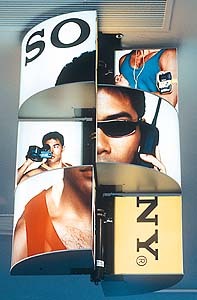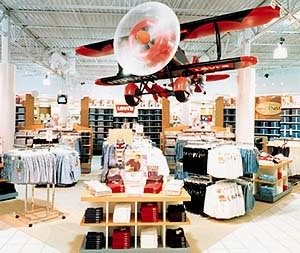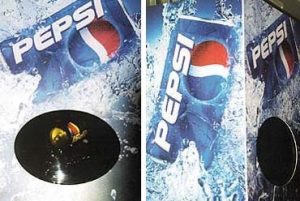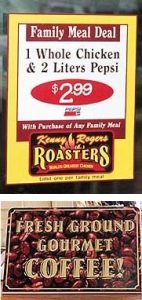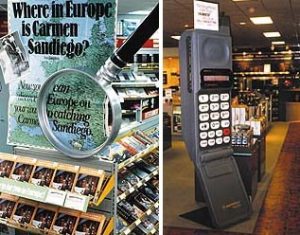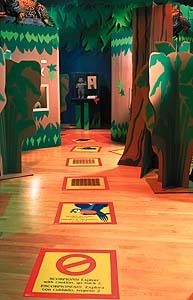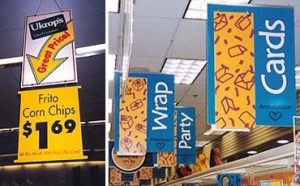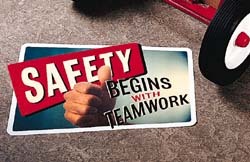Design
P-O-P Culture
Tapping a $12.7 billion industry
Published
18 years agoon
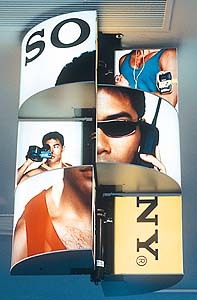
We at ST often meet with puzzled looks when mentioning to people that we write for a sign magazine. Sometimes, the first query is more of a clarification. "Did you say ‘science’ magazine?" Or if the person did understand the word to be "sign," the next question is, "So, what do you write about?" And then we have to define the concept of signs by using examples. "You know, a sign, like that rectangular structure above the door of that restaurant with words on it, that billboard on the highway or that poster on the metro bus. Those are all signs."
As sign-makers, you might have similar experiences. But the great thing about the sign business, as we industry professionals are all aware and as the general public does not entirely understand, is that signage comes in innumerable forms, it’s everywhere, and it’s important for business. That’s what makes the ever-changing sign industry so exciting. The fact is, the simple word "sign" refers to a wide range of structures, with the basic idea being that a sign conveys a message.
But what about point-of-purchase displays, otherwise known as "p-o-p"? If there was a line to be drawn regarding sign-industry parameters, would one line be drawn here? What does the p-o-p industry have to do with signage? Or, rather, should sign-makers get more involved in p-o-p, and if so, how?
Historically, signshop owners produced plenty of p-o-p signage for retailers. Of course back then, the displays often read simply "Two for One" or "Apples: 15 Cents a Pound." Today, p-o-p, like the sign industry itself, is much more complex. Many of today’s p-o-p displays are as simple as "Two for One," and others are more elaborate, such as interactive, computer-operated kiosks with accompanying shelves housing the product on display. And it’s no surprise that digital printing is another technology changing the face of p-o-p.
What is p-o-p?
Although p-o-p takes on many forms, it’s still easily recognizable. The Point-of-Purchase Adv. Institute (POPAI) defines p-o-p as displays, signs, structures and devices that are used to identify merchandise and/or advertise a product, service or outlet and serve as an aid to retail selling. We can further make the distinction that p-o-p is usually indoor signage.
In fact, when you look at p-o-p displays, they are the most inexpensive and direct form of product advertising. While outdoor billboards, out-of-home advertising, TV and radio all vie for the consumers’ collective attention out of store, p-o-p displays get you right where you are most likely to actually buy the product: in-store. Once in the store, the consumer is an easy target. One survey says 74 percent of all mass-merchandising purchase decisions take place in-store. As such, p-o-p’s importance in the advertising milieu becomes quite clear.
So, why has the advertising medium long been a stepchild of the advertising industry? Like signage, it is an often overlooked business consideration, something in which retailers don’t always think to invest much money. P-o-p has often been thought of more as a promotional, rather than an advertising medium. But, like on-premise signage itself, the p-o-p display has a direct, immediate and unavoidable impact on catching the consumers’ attention and clinching a sale with a creative, interesting design and execution.
The p-o-p industry is now, more than ever, popping up and getting noticed. In fact, POPAI estimated the size of the p-o-p industry at a healthy $12.7 billion in 1996, and the estimated 1997 figure was $13.1 billion, a 5-percent increase. And it continues to grow and thrive. According to POPAI, "The extent to which p-o-p advertising works for retailers was never as high as it is today. The materials used in today’s p-o-p displays are pretty sophisticated. Brand marketers have to customize p-o-p more than ever before. And there is more customization because different p-o-p displays work differently for every store."
The p-o-p industry, although still not as big as TV or radio advertising, is not taking a back seat to other forms of advertising anymore. Trends show that p-o-p is increasingly being integrated into retailers’ mix of advertising to encourage brand recognition and uniformity. For instance, if you’ve seen the Gap "swing" ads on TV, which advertise the retailers’ roomy khakis, look for its in-store displays and posters to echo the same images.
The sign industry and p-o-p
As a sign-maker, you might be thinking, "P-o-p sounds great, but what does it have to do with my business?" It’s true that much p-o-p conceptualizing is conducted by retailers’ in-house creatives. But the fabrication is subbed out to a p-o-p agency, digital-service bureau or sign-maker, depending on the complexity of the job. One trend that might prove helpful to sign-makers is that today, individual retail stores, rather than the companies producing the brands themselves, run the show. One POPAI spokesman says, "Retail is undergoing a pretty significant consolidation, and those that are surviving are branding their stores and taking control of what goes into their stores."
All this means that as more individual stores customize their p-o-p displays to appeal to their local clientele — which can vary quite a lot from region to region — the signage and displays are more likely to be fabricated locally.
If, for instance, your signshop creates a new or existing store’s on-premise signage, you’ve already established a relationship with the retailer. Instead of thinking of a store’s outdoor signage as a one-shot deal, this is a great opportunity to continue the relationship by creating in-store p-o-p signage, as well. And because of the relatively "temporary" nature of p-o-p signage — temporary refers to displays up for less than six months — the signage is changed often, translating to greater business potential for a signshop with the capabilities to serve this niche.
Consider also that many retail stores are not part of a chain. As such, local business owners might not have the budget to hire a separate advertising agency to help design p-o-p displays. As a signshop owner, you can combine your creativity with fabrication skills to create p-o-p displays for these stores on an ongoing basis.
Who needs it?
Now that you know what it is, how do you find customers who need it? According to POPAI’s survey, the restaurant/food service and tavern sector, and the apparel/footwear sector, are the top industry segments investing in p-o-p advertising, with more than $2 billion expended (in 1996). The magazine P-O-P Times puts out its own annual survey on the industry. In the 1998 P-O-P Times/P-O-P & Sign Design Trends Survey, p-o-p producers indicated specialty stores were the most receptive to p-o-p, followed by supermarkets and department stores.
Additionally, p-o-p producers ranked the percentages of p-o-p they sold in 1997. The results: 69.2 percent indicated selling non-electric signage; 57.3 percent sold temporary counter, shelf or table units; and 37.6 percent sold electric signage. And the survey says the average p-o-p producer makes an 18-cent profit for every display dollar spent, a nearly 20-percent profit per display.
Knowing what works to move a particular product is not an exact science. In fact, many manufacturers of major brand-name products monitor their p-o-p displays to find out what works and what doesn’t. But, according to Patrick Hare, group manager of consumer products for Nabisco Biscuit Co. (E. Hanover, NJ), color and size are two of the most critical measurements of a display’s effectiveness. Hare says, "[The display] has to make an impact but not disrupt the environment. It has to create an appeal to [the consumer’s] appetite, and the display must carry more than one product."
Brand manufacturers realize, however, that even if one display results in more product sales than another, the displays serve to enhance brand awareness. As sign-makers, you need to emphasize to your customers that p-o-p is an inexpensive, effective way not only to enhance sales, but to leave an impression on the customer, which can translate to future sales.
What’s popping up in the future?
The face of p-o-p displays is constantly changing. The graphics that might have been quite effective in the past may no longer attract the attention of today’s consumers. As such, Marilyn Doll, marketing manager of Grady McAuley, a graphics firm based in Canton, OH, says traditional signage doesn’t always work in the increasingly entertainment-oriented retail world. "Graphics are becoming more interactive, and the emphasis is on making displays more attractive, creating a more entertaining environment."
Grady McAuley creates a fair amount of p-o-p displays and signage for a number of large retail and gas-station chains, including K-Mart, Federal Express, Office Max, BP and Amoco. Doll says as part of K-Mart’s advertising campaign, Grady McAuley has fabricated floor graphics, displays and signage to promote new product lines and K-Mart’s new image. For one display, the company fabricated a life-size figure with a sensor so that when a customer passed by, the display could announce the new product.
Doll also adds that in general, p-o-p is more likely now to be semi-permanent or permanent (which can still refer to displays less than one year old) than temporary. Part of this trend arises from an increasing use of more sophisticated materials. At Grady McAuley, for example, Sintra

SPONSORED VIDEO
Introducing the Sign Industry Podcast
The Sign Industry Podcast is a platform for every sign person out there — from the old-timers who bent neon and hand-lettered boats to those venturing into new technologies — we want to get their stories out for everyone to hear. Come join us and listen to stories, learn tricks or techniques, and get insights of what’s to come. We are the world’s second oldest profession. The folks who started the world’s oldest profession needed a sign.
You may like

Avery Dennison Adopts Mimaki Printer for Traffic Sign Print System

Fiery Releases SignLab 11

21 Larry Albright Plasma Globes, Crackle Tubes and More
Subscribe

Bulletins
Get the most important news and business ideas from Signs of the Times magazine's news bulletin.
Most Popular
-

 Tip Sheet3 days ago
Tip Sheet3 days agoAlways Brand Yourself and Wear Fewer Hats — Two of April’s Sign Tips
-

 Business Management1 week ago
Business Management1 week agoWhen Should Sign Companies Hire Salespeople or Fire Customers?
-

 Women in Signs2 weeks ago
Women in Signs2 weeks ago2024 Women in Signs Award Winners Excel in Diverse Roles
-

 Real Deal4 days ago
Real Deal4 days agoA Woman Sign Company Owner Confronts a Sexist Wholesaler
-

 Editor's Note1 week ago
Editor's Note1 week agoWhy We Still Need the Women in Signs Award
-

 Maggie Harlow2 weeks ago
Maggie Harlow2 weeks agoThe Surprising Value Complaints Bring to Your Sign Company
-

 Line Time2 weeks ago
Line Time2 weeks agoOne Less Thing to Do for Sign Customers
-

 Product Buying + Technology1 week ago
Product Buying + Technology1 week agoADA Signs and More Uses for Engraving Machines
